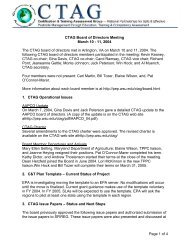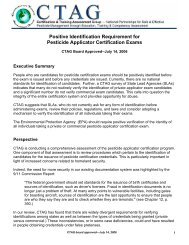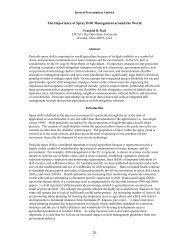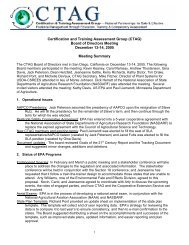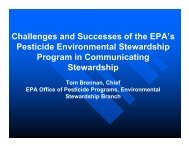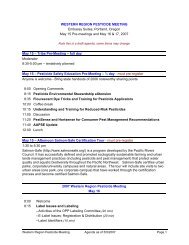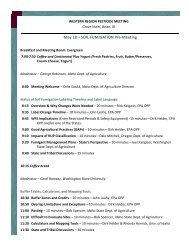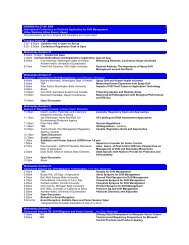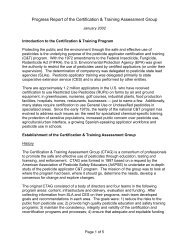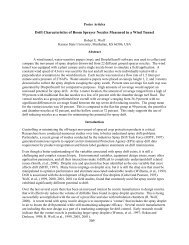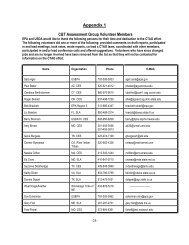156 Meteorological Concepts in the Drift of Pesticide
156 Meteorological Concepts in the Drift of Pesticide
156 Meteorological Concepts in the Drift of Pesticide
You also want an ePaper? Increase the reach of your titles
YUMPU automatically turns print PDFs into web optimized ePapers that Google loves.
Invited Presentation Articles<strong>Meteorological</strong> <strong>Concepts</strong> <strong>in</strong> <strong>the</strong> <strong>Drift</strong> <strong>of</strong> <strong>Pesticide</strong>Harold W. ThistleUSDA Forest ServiceMorgantown, WV, USAAbstractThe role <strong>of</strong> meteorology <strong>in</strong> pesticide drift is discussed. It is well known that <strong>the</strong> w<strong>in</strong>d speed is acritical factor. The <strong>in</strong>teraction <strong>of</strong> meteorological variables such as humidity and vertical temperaturestructure with airborne droplets is less well understood <strong>in</strong> <strong>the</strong> applicator community. A briefdiscussion <strong>of</strong> <strong>the</strong> relevant meteorological variables and <strong>the</strong> effect <strong>of</strong> <strong>the</strong>se variables on drift ispresented here.IntroductionMeteorology plays an important role <strong>in</strong> determ<strong>in</strong><strong>in</strong>g <strong>the</strong> movement <strong>of</strong> spray droplets <strong>in</strong> <strong>the</strong>atmosphere as well as where <strong>the</strong>se droplets land. Describ<strong>in</strong>g <strong>the</strong> exact movements <strong>of</strong> <strong>the</strong>se dropletschallenges <strong>the</strong> predictive capability <strong>of</strong> modern science. However, <strong>in</strong> a mean sense, <strong>the</strong> effect <strong>of</strong>meteorology on drift is understood and can be calculated.Recent work confirms that <strong>the</strong> three primary factors <strong>in</strong> drift are droplet size, release height andmeteorology (Hewitt et al., 2002). Immediately, it is apparent that two <strong>of</strong> <strong>the</strong>se are not meteorologicalfactors. Upon fur<strong>the</strong>r thought, it is clear that <strong>the</strong> story is not as simple as it may at first appear.Droplet size is critical because as smaller droplets are considered, <strong>the</strong> role <strong>of</strong> gravity is lessened and<strong>the</strong> role <strong>of</strong> <strong>the</strong> ambient w<strong>in</strong>d field is <strong>in</strong>creased. As <strong>the</strong> release height <strong>in</strong>creases, droplets will spendlonger <strong>in</strong> <strong>the</strong> atmosphere and <strong>the</strong> ambient w<strong>in</strong>d field will have a longer time to displace <strong>the</strong>m laterallyaway from <strong>the</strong> target. Thus, when <strong>the</strong> <strong>in</strong>terdependencies between variables are considered, it is clearthat, <strong>in</strong> a sense, meteorology is responsible for drift. The role <strong>of</strong> meteorology <strong>in</strong> <strong>the</strong> determ<strong>in</strong>ation <strong>of</strong><strong>the</strong> position <strong>of</strong> deposition is generally proportional to <strong>the</strong> amount <strong>of</strong> time <strong>the</strong> droplet is <strong>in</strong> <strong>the</strong>atmosphere. Thus <strong>in</strong> low boom ground sprayer applications where nozzles are po<strong>in</strong>ted downward, <strong>the</strong>vast majority <strong>of</strong> <strong>the</strong> spray material is not resident <strong>in</strong> <strong>the</strong> atmosphere for a long period and <strong>the</strong>refore isnot much <strong>in</strong>fluenced by meteorology. Note that even <strong>in</strong> this scenario, <strong>the</strong>re is a small fraction <strong>of</strong> <strong>the</strong>total mass <strong>of</strong> <strong>the</strong> spray material <strong>in</strong> very f<strong>in</strong>e drops that does not reach <strong>the</strong> surface. This material isavailable to drift. The <strong>in</strong>terdependency <strong>of</strong> <strong>the</strong> application parameters is apparent and lends itself tocomputer model<strong>in</strong>g. The role <strong>of</strong> meteorology will be illustrated here us<strong>in</strong>g modeled results. Themodel simulates aerial application but <strong>the</strong> po<strong>in</strong>ts made are relevant to all application scenarios. It is<strong>in</strong>terest<strong>in</strong>g that <strong>of</strong> <strong>the</strong> three dozen or so variables that are used by <strong>the</strong> model to calculate drift, thosethat are generally least controllable by <strong>the</strong> applicator are variables describ<strong>in</strong>g <strong>the</strong> meteorology andvariables describ<strong>in</strong>g <strong>the</strong> foliar canopy. Of <strong>the</strong>se two, only meteorology is constantly vary<strong>in</strong>g <strong>in</strong> timeand space.This paper <strong>the</strong>n addresses <strong>the</strong> role <strong>of</strong> meteorology <strong>in</strong> pesticide drift. Specifically <strong>the</strong> mechanisms <strong>of</strong>transport <strong>in</strong> <strong>the</strong> atmosphere that <strong>in</strong>fluence primary movement <strong>of</strong> spray material. Variance <strong>of</strong>meteorological variables is also discussed as well as <strong>the</strong> implication <strong>of</strong> this variance to <strong>of</strong>f-targetmovement. Measurement <strong>of</strong> <strong>the</strong>se variables as well as <strong>in</strong>terpretation <strong>of</strong> data is addressed <strong>in</strong> a separatetalk. It is obvious that only a very perfunctory discussion <strong>of</strong> <strong>the</strong> relevant meteorology is possible <strong>in</strong>this small space. For readers that would like additional <strong>in</strong>formation see Stull (1988), Pan<strong>of</strong>sky andDutton (1984), and Rosenberg(1974). These texts are <strong>in</strong>troductions to <strong>the</strong> various aspects <strong>of</strong>meteorology important to this subject.<strong>156</strong>
Invited Presentation ArticlesW<strong>in</strong>d Speed and DirectionW<strong>in</strong>d speed and direction are <strong>the</strong> primary meteorological determ<strong>in</strong>ants <strong>of</strong> <strong>the</strong> amount <strong>of</strong> material thatis moved <strong>of</strong>f-target as well as <strong>the</strong> direction that <strong>the</strong> material moves. Though w<strong>in</strong>d direction is notdiscussed <strong>in</strong> relation to <strong>the</strong> magnitude <strong>of</strong> drift from an application, if <strong>the</strong> consideration is to preventdrift to a specific location that is considered sensitive, <strong>the</strong>n w<strong>in</strong>d direction is <strong>the</strong> critical variable as <strong>the</strong>direction <strong>of</strong> air movement determ<strong>in</strong>es <strong>the</strong> direction <strong>in</strong> which material will drift. The fluctuation <strong>in</strong>w<strong>in</strong>d direction can also be used as an <strong>in</strong>dicator <strong>of</strong> <strong>the</strong> amount <strong>of</strong> atmospheric turbulence and,<strong>the</strong>refore, <strong>the</strong> amount <strong>of</strong> dilution <strong>of</strong> a cloud <strong>of</strong> f<strong>in</strong>e droplets.W<strong>in</strong>d speed guidance is now given on many pesticide labels <strong>in</strong> <strong>the</strong> United States. However, even with<strong>the</strong> attention that w<strong>in</strong>d speed has received, <strong>the</strong> regulatory and applicator community struggles with <strong>the</strong>concepts <strong>in</strong>volved <strong>in</strong> <strong>the</strong> transport <strong>of</strong> spray droplets <strong>in</strong> a three dimensional turbulent fluid such as <strong>the</strong>Earth’s surface layer atmosphere.A simple case study is developed to illum<strong>in</strong>ate <strong>the</strong> role <strong>of</strong> w<strong>in</strong>d speed <strong>in</strong> drift. AGDISP 8.08 (Teskeet al., 2003) does a reasonable job <strong>of</strong> simulat<strong>in</strong>g <strong>the</strong> position <strong>of</strong> deposition <strong>of</strong> droplets released <strong>in</strong>aerial spray<strong>in</strong>g. A strength <strong>of</strong> <strong>the</strong> model is <strong>in</strong> its basic (thoughsimplified) physical correctness and itsability to correctly portray trends and <strong>in</strong>teractions among variables <strong>in</strong> a mean sense. The methodselected a base case (Teske et al., 1993 ) that is a typical operational scenario (J. Creighton,International Paper, personal communication), <strong>in</strong> this case it is an aerial herbicid<strong>in</strong>g scenario <strong>of</strong> ayoung (short) p<strong>in</strong>e plantation. The output compares <strong>the</strong> deposition between 50 and 250m downw<strong>in</strong>d<strong>of</strong> <strong>the</strong> last swath edge. A summary <strong>of</strong> <strong>the</strong> base case is given <strong>in</strong> Table 1.Aircraft Bell 206B Jet RangerRelease Height 9.14 mW<strong>in</strong>d Speed 3.13 ms -1Number <strong>of</strong> 47NozzlesSpray Volume 93.5 Lha -1RateNon-Volatile .5FractionActive .075FractionTemperature 21.1°CRelative 75%HumidityVMD 852µmSwaths 20Table 1. Sensitivity ParametersAmbient w<strong>in</strong>d accomplishes <strong>the</strong> horizontal movement <strong>of</strong> <strong>the</strong>droplets as <strong>the</strong> aircraft wake vortices weaken. It can be seenfrom Figure 1 that <strong>the</strong>re are over two orders <strong>of</strong> magnitudemore drift <strong>in</strong> <strong>the</strong> high w<strong>in</strong>d speed case than <strong>the</strong> low. Noticethat <strong>in</strong> <strong>the</strong> low w<strong>in</strong>d speed case, <strong>the</strong> deposition at 250m is verylow (s<strong>in</strong>gle µg/m -2 ) even though <strong>the</strong> application rate is 93.5Lha -1 . Generally, w<strong>in</strong>d speed at application will be limited bylabel restriction to less than 4.5 ms -1 . Interest<strong>in</strong>gly, it has beenproposed to add low w<strong>in</strong>d speed restrictions to labels with <strong>the</strong>contention that low w<strong>in</strong>d speeds are associated withatmospheric <strong>in</strong>versions and are characterized by variabledirection.HumidityThe base case <strong>of</strong> Table 1. is used to <strong>in</strong>vestigate <strong>the</strong> role <strong>of</strong> humidity. The primary <strong>in</strong>fluence <strong>of</strong>humidity is to reduce <strong>the</strong> size <strong>of</strong> droplets through evaporation thus reduc<strong>in</strong>g droplet settl<strong>in</strong>g velocityand <strong>in</strong>creas<strong>in</strong>g <strong>the</strong> <strong>in</strong>fluence <strong>of</strong> ambient air movement. It can be seen from Figure 2 that deposition at250m varies by a factor <strong>of</strong> two between <strong>the</strong> low humidity and <strong>the</strong> high humidity cases. Low humidityconditions <strong>in</strong>crease drift by reduc<strong>in</strong>g <strong>the</strong> size <strong>of</strong> droplets after <strong>the</strong>y are sprayed through <strong>in</strong>creasedevaporation. The amount <strong>of</strong> potential evaporation is a direct function <strong>of</strong> <strong>the</strong> volatility <strong>of</strong> <strong>the</strong> sprayedmaterial. In <strong>the</strong> base case though only .075 <strong>of</strong> <strong>the</strong> spray material is active, <strong>the</strong> non-volatile fraction isspecified as .5 simulat<strong>in</strong>g <strong>the</strong> <strong>in</strong>clusion <strong>of</strong> an anti-evaporant or non-volatile <strong>in</strong>erts. If <strong>the</strong> mix was .075non-volatile AI mixed with .925 water, evaporation would be much higher. Rapid evaporation <strong>of</strong>material is more commonly a problem at high temperatures or <strong>in</strong> dry climates. It is <strong>of</strong>ten a controll<strong>in</strong>gfactor <strong>in</strong> <strong>the</strong> very dry climates <strong>of</strong> parts <strong>of</strong> <strong>the</strong> western United States157
Invited Presentation ArticlesFigure 1. W<strong>in</strong>d Speed Dependence. Thisgraph shows <strong>the</strong> modeled results <strong>of</strong> depositiondownw<strong>in</strong>d <strong>of</strong> <strong>the</strong> spray block for four w<strong>in</strong>d speedscenarios. The solid l<strong>in</strong>e is <strong>the</strong> base case, <strong>the</strong>w<strong>in</strong>d speeds progress<strong>in</strong>g from f<strong>in</strong>er dash tocoarser are 4.47ms -1 , 1.79ms -1 and .45ms -1respectively.Figure 2. Humidity Dependence. This graphshows <strong>the</strong> dependence <strong>of</strong> downw<strong>in</strong>d deposition onhumidity (modeled as relative humidity). The basecase is <strong>the</strong> solid l<strong>in</strong>e. The modeled humidity variesfrom coarser dash to f<strong>in</strong>er as 15%, 35%, 55% and95% respectively.VarianceAs <strong>the</strong> role <strong>of</strong> specific meteorological variables<strong>in</strong> <strong>of</strong>f-target drift is discussed, it is necessary todiscuss <strong>the</strong> implication <strong>of</strong> averag<strong>in</strong>g and <strong>the</strong>mean<strong>in</strong>g <strong>of</strong> a statement such as ‘w<strong>in</strong>d speedshould be less than 5 mph’. Figure 3 is a trace<strong>of</strong> w<strong>in</strong>d speed taken at 10Hz. It is immediatelyobvious that <strong>the</strong> w<strong>in</strong>d speed is extremely variable, even when measured ten times per second. Howdoes this variation effect <strong>the</strong> transport <strong>of</strong> a droplet? The first consideration is that fluid motion shouldnot be treated as a scalar quantity. It is a vector with magnitude (speed) and direction <strong>in</strong> threedimensions.Thus each measurement at 10Hz will have a different direction and speed <strong>of</strong> movementFigure 3. Trace <strong>of</strong> w<strong>in</strong>d speed measured at 1:30 pm, Feb. 1, 2002 <strong>in</strong> Ka<strong>in</strong>garoa Forest, NZ.Measured over a young Radiata p<strong>in</strong>e canopy. (From Thistle et al., 2004.)158
Invited Presentation Articles<strong>of</strong> <strong>the</strong> transport<strong>in</strong>g fluid (<strong>the</strong> w<strong>in</strong>d). Note that when a standard cup anemometer is used and a 15m<strong>in</strong>ute average w<strong>in</strong>d speed is stated, this is a scalar average. If <strong>the</strong> quick calculation is done that aneutrally buoyant droplet <strong>in</strong> a 5 ms -1 , 15 m<strong>in</strong>ute averaged w<strong>in</strong>d speed will move 4500 m downw<strong>in</strong>d <strong>in</strong>15 m<strong>in</strong>utes (5 ms -1 x 900 s) <strong>the</strong> answer arrived at is too large. Though it is <strong>the</strong> correct answer to <strong>the</strong>question ‘How far did <strong>the</strong> droplet travel?’ it is not <strong>the</strong> correct answer to <strong>the</strong> question ‘How far did <strong>the</strong>droplet move <strong>in</strong> <strong>the</strong> mean downw<strong>in</strong>d direction?’ The answer to that question must consider <strong>the</strong>amount <strong>of</strong> variance <strong>in</strong> <strong>the</strong> w<strong>in</strong>d direction and ultimately requires a vector resultant <strong>of</strong> <strong>the</strong> speeds anddirections <strong>in</strong> <strong>the</strong> series. This distance will always be less than <strong>the</strong> distance based on <strong>the</strong> scalaraveraged w<strong>in</strong>d speed.The reason that substantial variance is seen even at high frequency <strong>in</strong> <strong>the</strong>se time series is that <strong>the</strong>mean state <strong>of</strong> <strong>the</strong> atmosphere changes spatially and <strong>the</strong>se spatial gradients are large <strong>in</strong> <strong>the</strong> verticaldirection. The surface layer atmosphere is almost always <strong>in</strong> a highly turbulent state (large Reynold’sNumber). In a turbulent fluid, <strong>the</strong> mean motion is composed <strong>of</strong> roughly circular eddies translat<strong>in</strong>g <strong>in</strong>a direction parallel to <strong>the</strong> mean pressure gradient. In <strong>the</strong> surface boundary layer where most pesticideapplication occurs, <strong>the</strong> ground surface exerts drag on <strong>the</strong> fluid above and forms what modelers call ano-slip boundary. This implies that <strong>the</strong> fluid at <strong>the</strong> surface has zero velocity while <strong>the</strong> fluid <strong>in</strong> <strong>the</strong>layer immediately above is mov<strong>in</strong>g much more quickly. When <strong>the</strong> circular eddies move <strong>in</strong> thisvertical plane <strong>the</strong>y constantly downwash higher velocity fluid from above and lift slower mov<strong>in</strong>g fluidfrom below. This serves to mix <strong>the</strong> atmosphere, and when monitored from a po<strong>in</strong>t, <strong>the</strong> variance <strong>in</strong> <strong>the</strong>time series <strong>of</strong> <strong>the</strong> w<strong>in</strong>d can be related to <strong>the</strong> size <strong>of</strong> <strong>the</strong> eddies. Larger eddies move fluid from fur<strong>the</strong>raway vertically, and <strong>the</strong>refore from a region <strong>of</strong> much higher velocity, this shows up as a gust <strong>in</strong> <strong>the</strong>series. The discussion <strong>of</strong> variance <strong>in</strong> this context is important because <strong>the</strong> amount <strong>of</strong> variance can beused as a measure <strong>of</strong> mix<strong>in</strong>g <strong>in</strong> <strong>the</strong> atmosphere. Larger eddies will manifest as larger fluctuations <strong>in</strong> atime series <strong>of</strong> velocity. Larger eddies will also manifest <strong>the</strong>mselves <strong>in</strong> <strong>the</strong> time series <strong>of</strong> w<strong>in</strong>ddirection. Thus both <strong>the</strong> magnitude <strong>of</strong> variance <strong>in</strong> <strong>the</strong> time series <strong>of</strong> w<strong>in</strong>d as well as <strong>the</strong> magnitude <strong>of</strong>variance <strong>of</strong> <strong>the</strong> w<strong>in</strong>d direction can be used to <strong>in</strong>dicate <strong>the</strong> level <strong>of</strong> mix<strong>in</strong>g <strong>in</strong> <strong>the</strong> atmosphere. Theconcept <strong>of</strong> mix<strong>in</strong>g is <strong>in</strong>troduced because a release <strong>of</strong> pesticide can be thought <strong>of</strong> as populat<strong>in</strong>g avolume <strong>of</strong> <strong>the</strong> atmosphere with droplets. If mix<strong>in</strong>g is high (large eddies), material is mixed through alarge volume <strong>of</strong> atmosphere but is relatively dilute. If mix<strong>in</strong>g is low, <strong>the</strong> material is mixed through asmall volume <strong>of</strong> atmosphere but is more concentrated. The condition <strong>of</strong> <strong>the</strong> atmosphere thatdeterm<strong>in</strong>es <strong>the</strong> mix<strong>in</strong>g volume is stability and is discussed below.Solar Radiation and Energy BudgetsA fundamental po<strong>in</strong>t that is frequently overlooked is that <strong>the</strong> local meteorology is <strong>of</strong>ten dictated bylocal surface conditions and <strong>the</strong> <strong>in</strong>teraction <strong>of</strong> <strong>the</strong> surface with <strong>the</strong> <strong>in</strong>cident solar radiation. The sunemits radiation <strong>in</strong> high frequency waves that, <strong>in</strong> large part pass through <strong>the</strong> atmosphere with <strong>the</strong>important exception <strong>of</strong> a considerable segment reflected from cloud tops. This shortwave energy is<strong>in</strong>tercepted at <strong>the</strong> surface and ei<strong>the</strong>r reflected or absorbed. The surface <strong>the</strong>n heats up and emitsradiation at a much longer wavelength. This long wavelength energy is more susceptible to be<strong>in</strong>gabsorbed by components <strong>in</strong> <strong>the</strong> atmosphere. Thus, <strong>the</strong> atmosphere is heated from below. Theprocess reverses itself at night and <strong>the</strong> surface loses heat by radiation proportionally to <strong>the</strong>temperature <strong>of</strong> what <strong>the</strong> surface ‘sees’. This is <strong>the</strong> idea <strong>of</strong> a view factor. If <strong>the</strong>re is solid cloud cover,what <strong>the</strong> surface sees is <strong>the</strong> cloud base that is likely somewhat colder than <strong>the</strong> surface but notdramatically so, so <strong>the</strong> surface radiates heat to <strong>the</strong> clouds but substantial heat is radiated back as well.If it is a clear night, <strong>the</strong> surface sees outer space and radiates heat to space with very little energyradiat<strong>in</strong>g back. Thus on clear nights, <strong>the</strong> surface cools rapidly and becomes colder than <strong>the</strong> air aboveit.Energy <strong>in</strong>tercepted by <strong>the</strong> Earth’s surface is partitioned <strong>in</strong>to sensible heat (H) and latent heat (LE,o<strong>the</strong>r more m<strong>in</strong>or components <strong>of</strong> <strong>the</strong> energy budget are not considered here). H is <strong>the</strong> heat that wefeel as <strong>the</strong> atmosphere heats. LE is <strong>the</strong> heat energy that is stored <strong>in</strong> <strong>the</strong> phase change <strong>of</strong> water(evaporation) and is not available for heat<strong>in</strong>g. If <strong>the</strong>re is available water, <strong>in</strong>cident solar energy will beused for evaporation. Over a free water surface, <strong>the</strong> ratio H/LE which is known as <strong>the</strong> Bowen ratio,159
Invited Presentation Articleswill be around .1. In a very arid sett<strong>in</strong>g <strong>the</strong> Bowen Ratio will approach 1. The relevance to thisdiscussion is that wet surfaces will be cooler. Irrigated fields will have surface temperatures lowerthan nearby non-irrigated fields. A detailed discussion <strong>of</strong> this topic is beyond <strong>the</strong> scope <strong>of</strong> this brieftreatment but two po<strong>in</strong>ts need to be made. First, <strong>the</strong> atmosphere is cooler over a free water or wetsurface when evaporation is occurr<strong>in</strong>g. Second, <strong>the</strong> atmosphere is more humid near water or over awet surface. Both <strong>of</strong> <strong>the</strong>se facts have implications for spray drift.Atmospheric Stability and TurbulenceAtmospheric stability can be simply described by <strong>the</strong> change <strong>of</strong> temperature with height <strong>in</strong> <strong>the</strong>atmosphere. As one ga<strong>in</strong>s elevation <strong>in</strong> <strong>the</strong> atmosphere, <strong>the</strong>re is less atmosphere above you so <strong>the</strong>pressure <strong>of</strong> <strong>the</strong> overly<strong>in</strong>g atmosphere on a surface drops. Temperature <strong>in</strong> a fluid is related to pressureso <strong>the</strong> temperature drops as well. This effect is always present and results <strong>in</strong> a temperature drop <strong>of</strong>about .065 ºC/10 m vertically on average (Whiteman, 2000). To simplify our discussion here we willignore this effect as it is small <strong>in</strong> <strong>the</strong> layer <strong>of</strong> <strong>in</strong>terest and def<strong>in</strong>e a stable atmosphere as one <strong>in</strong> which<strong>the</strong> temperature <strong>in</strong>creases with height, an unstable atmosphere as one <strong>in</strong> which <strong>the</strong> temperaturedecreases with height and a neutral atmosphere as one which doesn’t change temperature with height.The reason that stability is important <strong>in</strong> dispersion <strong>of</strong> f<strong>in</strong>e droplets is through its role <strong>in</strong> suppress<strong>in</strong>g orenhanc<strong>in</strong>g <strong>the</strong> ambient turbulence. In a stable atmosphere, warm air overlies cold air. If <strong>the</strong> air <strong>in</strong> thislayer is displaced lower it is warmer than <strong>the</strong> layer it enters and it rises, if it is raised above its layer <strong>of</strong>orig<strong>in</strong> it is colder than <strong>the</strong> air it moves <strong>in</strong>to and it s<strong>in</strong>ks. If air <strong>in</strong> this stable layer is displacedvertically, it returns to its vertical level <strong>of</strong> orig<strong>in</strong>. Thus if pesticide is released <strong>in</strong>to this layer, <strong>the</strong>drops that do not deposit with gravity stay <strong>in</strong> a narrow layer <strong>of</strong> <strong>the</strong> atmosphere and do not mix because<strong>the</strong> air is not mix<strong>in</strong>g.Conversely, <strong>in</strong> an unstable atmosphere, warm, less dense air is underneath cold air. If this air movesvertically it rises <strong>in</strong>to colder air and keeps on ris<strong>in</strong>g as it is less dense than <strong>the</strong> layer it moves <strong>in</strong>to. If itdrops, it drops <strong>in</strong>to warmer air and keeps dropp<strong>in</strong>g because it is heavier than <strong>the</strong> air below it. So, nomatter which direction it is displaced it keeps on mov<strong>in</strong>g away from its level <strong>of</strong> orig<strong>in</strong>. Hence, <strong>the</strong>layer is unstable as a slight perturbation sets <strong>the</strong> layer <strong>in</strong>to vertical motion and enhances turbulence.The displaced air can keep ris<strong>in</strong>g <strong>in</strong> many cases because <strong>of</strong> this mechanism and can end up far awayfrom its level <strong>of</strong> orig<strong>in</strong>. Thus, <strong>the</strong> boundary layer can be deep and pesticide released at <strong>the</strong> surfacemay mix through this deep volume. The pesticide <strong>in</strong> this well mixed layer is likely very dilute but<strong>in</strong>dividual small droplets could travel far.It needs to be emphasized that both strongly stable and strongly unstable layers generally do not exist<strong>in</strong> high w<strong>in</strong>ds, as <strong>the</strong> vertical layer<strong>in</strong>g is mixed and becomes uniform through mechanical mix<strong>in</strong>g asw<strong>in</strong>d speed <strong>in</strong>creases. Cloud cover prevents <strong>the</strong> basic mechanism <strong>of</strong> strong surface heat<strong>in</strong>g andcool<strong>in</strong>g from happen<strong>in</strong>g as it <strong>in</strong>hibits radiative exchange.The <strong>in</strong>fluence <strong>of</strong> stability on a given application scenario depends on <strong>the</strong> size <strong>of</strong> <strong>the</strong> droplets be<strong>in</strong>gsprayed. The fact that strongly stable and strongly unstable conditions are typically characterized bylow w<strong>in</strong>d speeds means that larger droplets will settle out close to <strong>the</strong> po<strong>in</strong>t <strong>of</strong> release. The <strong>in</strong>fluence<strong>of</strong> stability will <strong>in</strong>crease as <strong>the</strong> droplet diameter decreases. It may be said that stability is <strong>the</strong> thirdmost important variable <strong>in</strong> <strong>the</strong> movement <strong>of</strong> gaseous quantities <strong>in</strong> <strong>the</strong> atmosphere (after w<strong>in</strong>d speedand w<strong>in</strong>d direction). This is not <strong>the</strong> case <strong>in</strong> applications where large droplets are sprayed and <strong>the</strong>deposition is largely gravity driven. The role <strong>of</strong> stability may also be obscured by <strong>the</strong> <strong>in</strong>fluence <strong>of</strong> <strong>the</strong>aircraft wake <strong>in</strong> aerial application and <strong>the</strong> <strong>in</strong>fluence <strong>of</strong> downward jett<strong>in</strong>g from <strong>the</strong> nozzles <strong>in</strong> groundspray<strong>in</strong>g. In <strong>the</strong>se cases, impaction energy is mechanically imparted to <strong>the</strong> droplets and <strong>the</strong>y maydeposit before <strong>the</strong>y are <strong>in</strong>fluenced by atmospheric turbulence. Also, <strong>in</strong> <strong>the</strong> case <strong>of</strong> very low groundsprayer applications, <strong>the</strong> droplets are <strong>in</strong>itially <strong>in</strong>serted <strong>in</strong>to a low velocity layer near <strong>the</strong> surface. For<strong>in</strong>stance, <strong>in</strong> a vector control adulticid<strong>in</strong>g application where aerosol size droplets are desired and <strong>the</strong>yare released at heights over 40m, stability will play a critical role <strong>in</strong> <strong>the</strong> land<strong>in</strong>g position <strong>of</strong> <strong>the</strong>se160
Invited Presentation Articlesdroplets. Conversely, herbicide application from a low boom ground sprayer with spray VMD over500µm will have a small percentage <strong>of</strong> <strong>the</strong> total mass that will be significantly affected by stability.How to Recognize Inversion ConditionsStable conditions are <strong>of</strong>ten referred to as ‘<strong>in</strong>versions’. It is <strong>in</strong>version conditions that are <strong>of</strong> most<strong>in</strong>terest to applicators. Because <strong>of</strong> <strong>the</strong> low dispersion conditions <strong>in</strong> stable atmospheres, pesticidedroplets may rema<strong>in</strong> concentrated and drift <strong>of</strong>f target but rema<strong>in</strong> concentrated. This scenario canresult <strong>in</strong> a concentrated cloud <strong>of</strong> pesticide droplets land<strong>in</strong>g downw<strong>in</strong>d and possibly caus<strong>in</strong>g damage tonon-targets. Applicators <strong>of</strong>ten have a difficult time recogniz<strong>in</strong>g <strong>in</strong>version conditions because this isnot a meteorological quantity that is <strong>of</strong>ten discussed <strong>in</strong> <strong>the</strong> mass media even though, <strong>in</strong> larger bas<strong>in</strong>ssuch as <strong>the</strong> Central Valley <strong>of</strong> California and <strong>the</strong> Salt Lake Bas<strong>in</strong> (as well as smaller, populatedvalleys), <strong>in</strong>version conditions are now discussed <strong>in</strong> air quality report<strong>in</strong>g.Inversion conditions can <strong>in</strong> many cases be recognized through basic observation. The schemepresented <strong>in</strong> Table 2. is very useful <strong>in</strong> determ<strong>in</strong><strong>in</strong>g stability. Nighttime stability can only be ei<strong>the</strong>rneutral or stable. It is <strong>the</strong> transitions <strong>in</strong> <strong>the</strong> morn<strong>in</strong>g and even<strong>in</strong>g that are more difficult. If it is a cleardawn with low w<strong>in</strong>d, it is a high probability <strong>the</strong> observer is <strong>in</strong> an <strong>in</strong>version. After <strong>the</strong> sun rises, <strong>the</strong>surface beg<strong>in</strong>s to warm and <strong>the</strong> <strong>in</strong>version will rapidly break up over surfaces receiv<strong>in</strong>g direct sunlight.Initially, (until two to three hours after sunrise or so) <strong>the</strong> <strong>in</strong>version may still exist but it is elevated.This elevated <strong>in</strong>version can be important <strong>in</strong> aerial application as <strong>the</strong> surface atmosphere is not stable,but at <strong>the</strong> elevation <strong>the</strong> spray is be<strong>in</strong>g released it may be stable. Eventually, as <strong>the</strong> day progresses, itis expected that <strong>the</strong> entire surface layer will be unstable if <strong>the</strong> sun is sh<strong>in</strong><strong>in</strong>g on <strong>the</strong> surface. As <strong>the</strong>sun sets, <strong>the</strong> surface is no longer be<strong>in</strong>g heated by solar radiation and beg<strong>in</strong>s to cool. The surfacelayer <strong>the</strong>n shifts to stable aga<strong>in</strong>. The breakup <strong>of</strong> <strong>the</strong> morn<strong>in</strong>g <strong>in</strong>version tends to be abrupt, while <strong>the</strong>even<strong>in</strong>g transition from unstable to stable tends to be gradual. Keep <strong>in</strong> m<strong>in</strong>d that under cloud cover or<strong>in</strong> higher w<strong>in</strong>ds, <strong>the</strong> atmosphere is neutral so stability is not a concern.Table 2. Pasquill Stability Categories (Modified from Pasquill, 1974).ConclusionsMeteorology is critical to pesticide drift. A basic discussion <strong>of</strong> meteorological concepts demonstrates<strong>the</strong> role <strong>of</strong> w<strong>in</strong>d speed and direction, humidity and atmospheric stability. Variability <strong>of</strong>meteorological data is also discussed <strong>in</strong> terms <strong>of</strong> drift. A basic understand<strong>in</strong>g <strong>of</strong> <strong>the</strong> role <strong>of</strong>meteorology will aid applicators <strong>in</strong> avoid<strong>in</strong>g pesticide drift.161
Invited Presentation ArticlesBibliographyHewitt, A. J., D. R. Johnson, J. D. Fish, C. G. Hermansky, and D. L. Valcore. 2002. Development <strong>of</strong><strong>the</strong> spray drift task force database for aerial applications. Environmental Toxicology andChemistry 21(3):648-658.Pan<strong>of</strong>sky, H.A. and J.A. Dutton. 1984. Atmospheric Turbulence: Models and Methods forEng<strong>in</strong>eer<strong>in</strong>g Applications. New York, John Wiley and Sons.Pasquill, F. 1974. Atmospheric Diffusion. New York. John Wiley and Sons.Rosenberg, N.J. 1974. Micro-Climate: The Biological Environment. John Wiley and Sons, NewYork.Stull, R.B. 1988. An Introduction to Boundary Layer Meteorology. Boston MA, Kluwer AcademicPublishers.Teske M. E. and J. W. Barry. 1993. Parametric sensitivity <strong>in</strong> aerial application. Transactions <strong>of</strong> <strong>the</strong>ASAE. 36: 27–33.Teske M.E., H.W. Thistle and G.G. Ice. 2003. ‘Technical Advances <strong>in</strong> Model<strong>in</strong>g Aerially AppliedSprays’. Transactions <strong>of</strong> <strong>the</strong> American Society <strong>of</strong> Agricultural Eng<strong>in</strong>eers. Vol. 46 #4 pp. 985-996.Thistle H.W., M.E. Teske and B. Richardson. 2004. Spray Droplet Trajectory Length <strong>in</strong> AmbientVortices. ASAE Technical Paper #041088, St. Joseph, MI.Whiteman C.D. 2000. Mounta<strong>in</strong> Meteorology: Fundamentals and Applications. New York, OxfordUniversity Press.162



